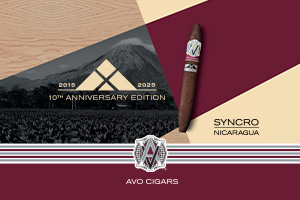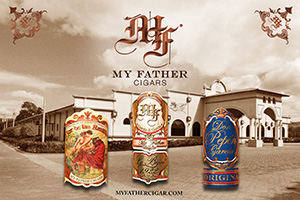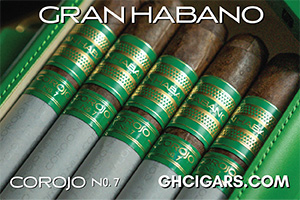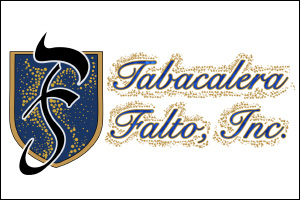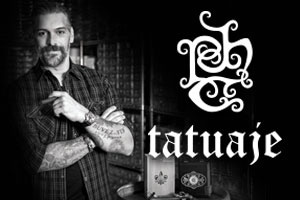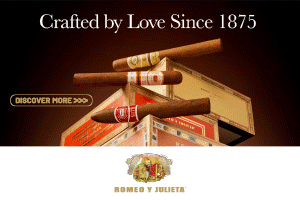Pete Johnson of Tatuaje – His First Interview
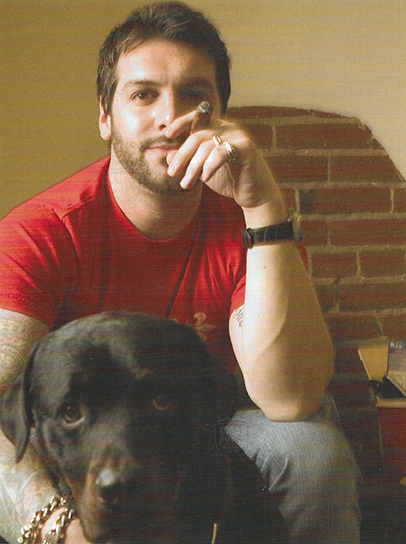 In 2007 we sat down with Pete Johnson for the Premiere issue, Volume 1 Issue 1 of Cigar Press Magazine. This was his first interview for a magazine and nearly two decades later there is still great information that can be found. We learned how he first got into cigars, what led to the creation of Tatuaje and much more. There were only five thousand copies printed back then so if you weren’t around or didn’t have the chance to get your hands on a copy, now is your chance to check it out.
In 2007 we sat down with Pete Johnson for the Premiere issue, Volume 1 Issue 1 of Cigar Press Magazine. This was his first interview for a magazine and nearly two decades later there is still great information that can be found. We learned how he first got into cigars, what led to the creation of Tatuaje and much more. There were only five thousand copies printed back then so if you weren’t around or didn’t have the chance to get your hands on a copy, now is your chance to check it out.
Tatuaje is only a few years old but already being marked as one of the best cigars on the market. Created by LA resident Pete Johnson, he is far from the classic image of a cigar man. He’s a rocker to the bone. While Pete’s fingers were getting raw slamming bass chords on stage, he started smoking cigars. He was captivated by cigar culture and literally swept away with it. Pete has been in the business for over a decade in one form or the other. He has been embraced by the industry and gains respect from his peers and mentors.
Nicknamed “Tattoo Pete” by the Fuentes and others in the industry, the name has stuck. Pete has more tattoos than just a right sleeve, and several of them are dedicated to cigars and tobacco. Cigar Press spent some time with Pete at his new shop in Little Havana on the Sunset Strip in Hollywood, California. We captured an up close and personal side of Pete for his first published interview. We learned what drives him to produce his cigars, what lies in store for Tatuaje fans, and how he plans to explore his other creative outlets.
Cigar Press – Why did you first come out to Los Angeles? What were you doing here?
Pete Johnson —I took a trip here with two friends to goof around. We were all musicians. I actually used to walk this street [Sunset Boulevard] many times. We stayed at the Day’s Inn, right next to In-N-Out Burger. After a lot of drunken nights with Jagermeister I fell in love with the place and had to move here. I went back home and was offered a summer job for a college print shop. I worked for the whole summer and saved about 2,500 bucks to move out here. Within a month I had found my band and moved to San Diego. My other band members lived down there so I lived in San Diego for about three months while we were getting ready for a mini tour. They already had a tour lined up and they needed a bass player, so I joined.
CP — What kind of music did you guys play?
Pete — When we first started we were just like all the other pretty-boy bands out there. At first we were mixed into the whole LA glam shit, not really glam but more like Guns N’ Roses glam. Then eventually, more like Alice in Chains. We were hard rock.
CP — When did you start smoking cigars?
Pete – I started while I was in my band.
CP — Do you remember your first cigar?
Pete — My first cigar was when I was about 12. I actually used to steal them from grocery stores. Tiparillos and shit like that.
CP — That brings back memories. Now they’ve wised up and put all tobacco behind the cashier. The good ‘ol days.
Pete — We didn’t get good stuff. My first good cigar was when I was in my band. I saw something on TV where all these guys were smoking cigars. I thought to myself, I haven’t had a cigar in a long time. So I went into a store and got a real cheapie. I smoked it and enjoyed the fact that I could just chill for a while. I couldn’t believe how much I paid for my first real good cigar, two dollars.
CP — So this was a long time ago.
Pete — This was around ’91 or ’92. I bought a real cigar from a real tobacco store. I couldn’t believe how much it was. But then it got to be a fixation for me. I went out and searched for my favorite cigar and what cigar I thought smelled good. My first box of cigars that I bought was Private Stock. That’s back when Private Stock was Davidoff. I went through hundreds of cigars before I found the one that smelled really good and tasted really good to me. It wasthe Davidoff Private Stock # 11, a robusto that I loved. I also smoked a lot of Fuente Chateaus. I ended up smoking a pipe in the morning. I had my own little smoking chair. I’d sit down and smoke a pipe, not a bowl, a pipe. Then I started to smoke cigars in the morning. I remember once I stopped at Vendome Liquors,who I actually sell cigars to now, in order to pick up another Chateau after my morning cigar. I almost got sick because I smoked so much that morning without any food in my stomach. All I needed was to get a little food in me.
CP — Nicotine overload.
Pete — Total nicotine overload.
CP — You developed a reputation with cigars from your band, didn’t you smoke while you played?
Pete — People actually thought I was crazy. I would have a cigar in my mouth while I was playing the whole show. I used to sling my bass really low so I had to crank down on it. I’d be smoking a cigar the whole time we were playing. I had to learn to breathe with a cigar in my mouth. That’s the hardest thing to do, especially when you’re doing a lot of other things.
CP — How did you go from lighting up the stage to working in a cigar shop?
 Pete — I was working at a job that I didn’t like. The music industry was pissing me off and I actually wanted to get out of Los Angeles. I had thought about moving back to Maine to open a cigar store. I actually went to this one shop in LA a lot. One of the guys who worked at the shop, the guy who really turned me on to enjoying all the little nuances and flavors of a cigar and tobacco, asked me if I wanted a job on Sundays. That was Gus’ Smoke Shop in Studio City. I would mix pipe tobacco, stock the humidor, work the register, things like that. Within six months I actually became the buyer for the shop. I’d search out all the unique brands and cigars that were coming out. When I first got into the business heavily, I met a guy named Rolando Reyes Jr. at my first RTDA. He was coming out with this new cigar, Puros Indios, part of the Aliados brand. I was already in the business for a few years before my first RTDA (Now PCA). I secured a spot to be one of his first retailers. For about six or eight months we had a lock on the brand on the whole state of California. There were maybe eight shops in the whole country that carried it. We were getting calls from all over trying to buy Puros Indios. They were getting huge ratings, 92s, 93s, everybody wanted it, and we were one of the only shops that had it.
Pete — I was working at a job that I didn’t like. The music industry was pissing me off and I actually wanted to get out of Los Angeles. I had thought about moving back to Maine to open a cigar store. I actually went to this one shop in LA a lot. One of the guys who worked at the shop, the guy who really turned me on to enjoying all the little nuances and flavors of a cigar and tobacco, asked me if I wanted a job on Sundays. That was Gus’ Smoke Shop in Studio City. I would mix pipe tobacco, stock the humidor, work the register, things like that. Within six months I actually became the buyer for the shop. I’d search out all the unique brands and cigars that were coming out. When I first got into the business heavily, I met a guy named Rolando Reyes Jr. at my first RTDA. He was coming out with this new cigar, Puros Indios, part of the Aliados brand. I was already in the business for a few years before my first RTDA (Now PCA). I secured a spot to be one of his first retailers. For about six or eight months we had a lock on the brand on the whole state of California. There were maybe eight shops in the whole country that carried it. We were getting calls from all over trying to buy Puros Indios. They were getting huge ratings, 92s, 93s, everybody wanted it, and we were one of the only shops that had it.
CP — So you found that brand in time to get it before anyone else.
Pete — That and Padron.
CP — Didn’t you also have one of the first Opus X accounts in the country?
Pete — Not with Gus’ Cigar Shop. By that time I had quit Gus’ and was working for a store called the Big Easy, this was now ’95. In ‘95 I actually took a little break and wanted to start my own brand. After I really got into cigars and started to understand all the different parts of a cigar, and how you can get different flavors from using different tobaccos, I thought that was really fascinating and something I could get into and enjoy. I was out of the music business for a while and didn’t even want to hear about it, but I got cigars and I understood them. I took my first trip to the Dominican in ’95 and spent a lot of time with the Fuente family.
CP — That must have been a fun time to visit.
Pete — No, it was bad actually. Everybody was trying to make cigars back then. I walked into a few factories and certain people said they could give me a cigar, but it was basically their cigar with a different band. What am I going to do with that? It was basically a private label of their own cigar. All the really good factories I wanted to be a part of, such as the Fuentes, didn’t have any time to deal with anybody. ’94, 95 was when the boom was just crazy. There was so much crap out there. A lot of the smaller people who were out there, were there to make a quick buck and capitalize on the fact that everyone was smoking cigars. People could take a 50-cent cigar and throw a fancy label on it with a five-dollar price tag. Those companies made a lot of money, but they’re no longer around.
CP — Now there are just a handful of people who have remained.
Pete — Doug Wood is still around, Alec Bradley, and Mike Chiusano are still around, and that’s because they wanted to make good cigars and be in it for the long run, not just for a quick buck. There were certain brands you wanted to buy, and certain ones you just wanted to stay away from. There were far more of the ones you didn’t want to buy.
CP — At least today the number of imports are still slowly growing and all of the cigars being made are geared to satisfy the dedicated cigar smoker.
Pete — Now cigar smokers really know what they want. Manufacturers understand that and don’t want to put crap out into the market. They were called out if they made shit, and even the big companies were making shit because it would sell. Now you can’t fool anybody. There are a couple new companies that have come out in the last year or so that are only really doing it so they can make money.
CP — When did the Grand Havana Room become part of your life?
Pete – I had a friend who really enjoyed my cigar recommendations, and he told me about this club that was opening up. I was actually going to‘join before the club opened but then the grand opening camev and I joined a week later. I basically took every penny I made and spent it on two things: cigars and a membership to the Grand Havana Room. Those were my priorities at the time. Then two years later in ‘97 they were opening the retail end of the business so I started doing that in September of the same year.
CP — Did you help out with all the retail locations?
Pete — They opened one in New York, one in Vegas, and they were opening the one here in Beverly Hills. It was probably the worst time in my life moving to Vegas for a month to open a store. Being a gambler and losing your money in the first week, the next three were pretty bad. I started doing all the purchasing for the retail end, organizing, and getting employees. I sort of lost touch with the market because I was sitting behind a desk the whole time. When I was finally able to get back into the store it was a sigh of relief. I actually enjoyed talking to people and hearing firsthand about new cigars that were coming out. When you sit at a desk pushing a pencil you don’t see that. I lost the thrill of the cigar business and almost got out to try something different. I thought the cigar business sucked at the time. The boom was dying and nothing was going on. Ashton called me up to send in my résumé to see if I wanted to be one of their sales reps, but I had just started Grand Havana and didn’t want to give that up if I was staying in the business. I had also just met my future wife, so I didn’t want to be traveling all over anymore.
CP — You’re pretty good at guessing cigars without bands, and you used to be tested by a few different people. Could you usually tell what it was?
Pete — A lot of times I got it on the second guess. I’d get familiar with the smells and aromas of a lot of different cigars. I was tested by guys like George Brightman, who used to work for Aficionado. He was also tested when he was younger by people like Manuel Quesada and Juan Sosa. They’d give him cigars and tell him to smoke them and come back in an hour and tell them what he thought of them. George is amazing. He is one of those guys who really knows his tobacco. He is really good at what he does. We used to test each other. I brought a cigar to a Chicago Big Smoke that I thought would fool anyone. I gave him a Romeo Cazador. Normally Cazadores are a naturally ugly cigar, but the one I had was just beautiful, pristine. He didn’t even light it. He put it in his mouth and said this is a Romeo Cazador. I kind of followed his lead. I really wanted to do that. When people would give me stuff I would try to guess. The first cigar he gave me I got wrong on the first guess. I told him a certain cigar name, and he told me to go back to school. I thought about it for a second and told him what it was. There were two cigars that were identical to this cigar. But I picked the right one because of the wrapper color. After that it was something I constantly had to do. A lot of times it was an illusion. I might know what you have in your inventory. It’s a total bluff game. I know the sizes, the cigars themselves, and would narrow down my choices. One time I literally went through every different cigar in a humidor and smelled them all, just so I could see what different countries smell like. When I did that companies weren’t blending different countries like today, usually cigars were made with one country.
CP — It must get pretty tough for you these days when some cigars have up to seven or eight countries in the blend.
Pete — Yeah that, and also nowadays Nicaraguan tobacco is smoking so much like Cuban tobacco that they fool a lot of people. When I first smoked Opus X, Carlito [Fuente] gave me a few before they came out when they were doing an event at the Grand Havana. I was able to meet him there and smoke a couple of the cigars. I thought to myself that those cigars were better than any Cuban out there. When they first released Opus X to the east coast, I already had an Opus X tattoo on my arm. I was such a diehard cigar fan. Opus X was one of those cigars that just really hit me. To me, there were no other cigars that I liked better, except some Cubans. Access to Cubans was iffy, and there were a ton of counterfeits so you had to be careful. The Opus X back then was a special treat, especially right off the bench.
CP — So how many of your tattoos did you have when you came into the cigar business?
Pete — I was actually fully sleeved on my right arm, but I had a few open spots. So I got the Opus X tattoo and a few tobacco flowers. There were some friends of mine like Litto Gomez who really took me under their wing. He was pretty new to the business but he was one of the coolest guys. There was no bullshit about him. He’ll tell you how it is. After I got the Opus X tattoo I was thinking what else I should get. La Flor Dominicana came to mind, the tobacco flower. That’s cool because it represents everything about tobacco, not just La Flor Dominicana. I save my left arm though, it’s my tribute arm. When my first dog died I got his initials, my other dog’s name, and the Tatuaje logo. Eventually it will be all filled up with things that are meaningful to me personally.
CP — You have a lot of people you look up to in the industry, a lot of mentors.
Pete — All the guys who took me under their wing. The Fuentes treated me like family. Carlito [Fuente] was like my big brother, which was a lot of fun. Robbie Levin is basically like a giant version of what I am. He doesn’t make any cigars, but he has people make cigars that are his brands. My first trip to the D.R. was with Carlos [Fuente] Sr., Carlito [Fuente], and Robbie [Levin]. I grew up looking up to them. Guillermo Leon, Litto Gomez, all these people were really kind and generous to me when I first started. I’ll always look up to these guys. There’s one guy left that I still get nervous around, and that’s the old man, Carlos [Fuente] Sr. He’s just one of those guys that you just want to shake his hand every time you see him. When I saw Carlito last he asked me, “Why don’t you ever give me a cigar?” I told him, “Honestly, I don’t want you to critique it.” I know he will. Litto smoked my stuff and gave me some nice compliments. The Padrons also,I used to talk to Jorge when I first started buying from them every few days. One, to ask some questions, and two, to get some more Padron Anniversarios. Those cigars were just like they are today, the hottest ticket. Back then you couldn’t get them, but I got whatever I needed because he enjoyed talking to me.
CP — How did you finally get hooked up with Pepin?
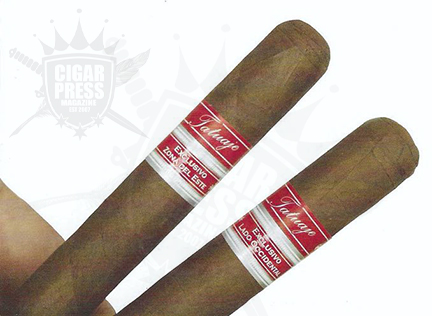 Pete — An old sales rep of mine who would come into the shop started working for a company called Tropical Tobacco, which was owned by Pedro Martin. So my rep came to me and asked; “You want to do a cigar really bad don’t you?” I told him, “Since ’94!” So he had this guy named Jose Garcia, Pepin, come out to LA. He and I sat at the Grand Havana Room one day and we started making cigars. After he was blending cigars for me, I didn’t think it was anything too fancy. So he asked me what I wanted, and | told him that I wanted what he knows the best. Everybody that he met with wanted him to make an Opus, or Padron Anniversario, or VSG. I wanted a Cuban cigar. When I first met him he was actually about a year out of Cuba. I told him to make me a Cuban cigar. I had this one box of Cuban cigars that was just smoking perfectly. I knew that this was a great cigar. I gave Pepin one and said to him, make me this. About five minutes later he made me one to try, and this thing was absolutely perfect. It had a lot of body and flavor to it, but it wasn’t overpowering. It smelled and tasted so good that it was actually refreshing to your palate. It made you want to smoke another one. We knew we hit something. About a week later I was smoking the samples again but this time I thought they were lacking something. It was almost too thin. They were great off the bench, but thinned out with a little time. I called Pepin and told him to kick up the blend a little more, make it a little stronger. It needed more depth. When I got more samples I would have sworn that I was smoking a Cuban cigar. | told him let’s do it. This is when Pepin was working with his family. His wife was wetting the leaves, his daughter was banding the cigars, his son, Jaime, was rolling cigars and also in control of making sure the packaging was right. They also had a few friends who were helping them out. They were all working from someone else’s warehouse. A few months later they wanted to show me their new place. It was a new little factory down in Miami. I started working with Pepin in March of 2003. By May, he was making my product full time. Now we’re like family. From May to December I didn’t sell a lot of cigars, maybe 20,000, all to my friends. I called all the cigar shops that I knew and asked if they wanted to try this new cigar I was making. My first tradeshow with the brand was in Nashville. I literally put the cigars in my friend’s booth. I walked away and did my work for Grand Havana. I still had to go get all the orders. People started calling me to tell me that I needed to come take orders at the booth, people wanted to order my cigars. I was a little shocked, but it was really cool. I walked away with about eight or ten orders. I thought it was pretty fun. I didn’t expect to sell any. As time went on, more and more people caught on. Shortly after that, Cigar Aficionado decided to do this top 25 thing and the first year I was number 25. That was great. I was never the guy who would call up cigar stores to try to get them to buy my cigars. Unless they were people I really knew, I wouldn’t call them. Actually, when I moved to Los Angeles I was working for a printer literally across the street from where my shop is now. All of my other band members were doing telemarketing. I thought that was the worst job in the world. When I got my own brand, I said that I was never going to push this on anyone. If they want to carry it, great, I’ll sell it to them. I’ll never be the guy who tells them you have to buy this cigar or tell them it’s the best cigar in the world. Because is it? No. But I like it, if other people like it, great. | got my point across. But I’ll never throw this down anyone’s throat and tell them that they need to have it. If people like it, if they want to buy it, cool.
Pete — An old sales rep of mine who would come into the shop started working for a company called Tropical Tobacco, which was owned by Pedro Martin. So my rep came to me and asked; “You want to do a cigar really bad don’t you?” I told him, “Since ’94!” So he had this guy named Jose Garcia, Pepin, come out to LA. He and I sat at the Grand Havana Room one day and we started making cigars. After he was blending cigars for me, I didn’t think it was anything too fancy. So he asked me what I wanted, and | told him that I wanted what he knows the best. Everybody that he met with wanted him to make an Opus, or Padron Anniversario, or VSG. I wanted a Cuban cigar. When I first met him he was actually about a year out of Cuba. I told him to make me a Cuban cigar. I had this one box of Cuban cigars that was just smoking perfectly. I knew that this was a great cigar. I gave Pepin one and said to him, make me this. About five minutes later he made me one to try, and this thing was absolutely perfect. It had a lot of body and flavor to it, but it wasn’t overpowering. It smelled and tasted so good that it was actually refreshing to your palate. It made you want to smoke another one. We knew we hit something. About a week later I was smoking the samples again but this time I thought they were lacking something. It was almost too thin. They were great off the bench, but thinned out with a little time. I called Pepin and told him to kick up the blend a little more, make it a little stronger. It needed more depth. When I got more samples I would have sworn that I was smoking a Cuban cigar. | told him let’s do it. This is when Pepin was working with his family. His wife was wetting the leaves, his daughter was banding the cigars, his son, Jaime, was rolling cigars and also in control of making sure the packaging was right. They also had a few friends who were helping them out. They were all working from someone else’s warehouse. A few months later they wanted to show me their new place. It was a new little factory down in Miami. I started working with Pepin in March of 2003. By May, he was making my product full time. Now we’re like family. From May to December I didn’t sell a lot of cigars, maybe 20,000, all to my friends. I called all the cigar shops that I knew and asked if they wanted to try this new cigar I was making. My first tradeshow with the brand was in Nashville. I literally put the cigars in my friend’s booth. I walked away and did my work for Grand Havana. I still had to go get all the orders. People started calling me to tell me that I needed to come take orders at the booth, people wanted to order my cigars. I was a little shocked, but it was really cool. I walked away with about eight or ten orders. I thought it was pretty fun. I didn’t expect to sell any. As time went on, more and more people caught on. Shortly after that, Cigar Aficionado decided to do this top 25 thing and the first year I was number 25. That was great. I was never the guy who would call up cigar stores to try to get them to buy my cigars. Unless they were people I really knew, I wouldn’t call them. Actually, when I moved to Los Angeles I was working for a printer literally across the street from where my shop is now. All of my other band members were doing telemarketing. I thought that was the worst job in the world. When I got my own brand, I said that I was never going to push this on anyone. If they want to carry it, great, I’ll sell it to them. I’ll never be the guy who tells them you have to buy this cigar or tell them it’s the best cigar in the world. Because is it? No. But I like it, if other people like it, great. | got my point across. But I’ll never throw this down anyone’s throat and tell them that they need to have it. If people like it, if they want to buy it, cool.
CP — Now everyone wants it.
Pete — Now it’s a little bit of trouble for me. Before the factory would call me and say, “Pete, you need to make more cigars.” I didn’t have enough customers, and I wanted to do this slowly. Every time I got a rating from a magazine, more and more people would call me. It worked out. The slower I grew, the better the factory got at making cigars. Even though they were good in the beginning, everyone has growing pains. Even with the Nicaraguan factory, they had to go in and train all these rollers. They basically went in and cleaned house. They re-trained every worker. They realized who they could train and who they couldn’t. The Nicaraguan factory is basically a bigger version of the Miami factory. The quality in Nicaragua is just as good as Miami, we’re just doing different blends. That’s why we keep them separated. Truthfully a lot of companies would move factories and not tell any- one about it. I didn’t want to come out with the original brown label cigar and as soon as Nicaragua opened up, do the same thing in Nicaragua. I wanted to show that we’re going to do a different cigar in Nicaragua, and have a separation between the brands. That worked out better for me. Working with Pepin for three and a half years didn’t only make us like family, it gave me a lot of insight to how he works with his tobacco. Then I was able to blend a new cigar with him in Nicaragua, the red label, Havana VI. I think the stuff coming out of Nicaragua is just as good, if not better that what we’re doing in Miami.
CP — You were Pepin’s first cigar right?
Pete — He had no one. I had no accounts and he had no accounts. We grew together. He is like my other father, Jaime is like my other brother. It’s just one of those things. I’m like the little red-headed stepchild that bitches and moans every once and a while. I think that they understand that I’ll always be the one family member who pinches a nerve every once and a while.
CP — When you made the brown label, what sizes did you start out with?
Pete — I started with six sizes. When I met Pepin, I had something happen to me where I felt like I really had to do something on my own, to give myself some identity. Otherwise I was just going to sit behind a counter for the rest of my life. Those six sizes all had a personal meaning to me. After that I wanted to come out with something that was really strong. Not something that was overwhelming on the palate, but really flavorful. One of those cigars that would kinda mislead you. When you start out you would think that it’s kinda easy, but then as you smoke it you realize you need to get some food in your stomach.
CP – Tell me about Cojonu.
Pete — We were joking around at the factory one day with names. Someone made a comment about this word, cojonu. I asked what that was. They told me, it’s like being ballsy, or a ball buster. Almost like cojones but it’s Cuban slang, it’s short for cojonudo. I looked at the cigar and said this is Cojonu. They said, “No, you can’t call it cojonu.” But I did, and now it’s a joke in the Cuban community. People saw the name and laughed their asses off. That was my seventh cigar. After that I started adding cigars with the different sizes that I wanted to do. The first six are my core cigars. Then we came out with what are more or less special edition things. I have three reserves and two limited cigars. That’s all in the original brown label, and then I added the petit.
CP — What about Havana VI?
Pete — I came up with six sizes in the red. Pretty soon it’s going to be eight, with two limited editions. And then Cabaiguan came on. I wanted to do another cigar with the factory, but I wanted to do something lighter. They told me they could get this wrapper from the same people who were giving Davidoff their wrappers. It’s a Connecticut Ecuador. We made a couple cigars and I thought it was missing a couple things and it was a little sour. I told them I needed a little more sweetness. I liked the strength but I was missing something. A light bulb went off in Pepin and Jaime’s heads. They ran to their tobacco stash and grabbed this one leaf. They blended it with another one and added it to the blend and gave it to me to smoke. It was perfect, that’s how I came up with Cabaiguan. Cabaiguan is just an extension of my brand that | wanted to do.
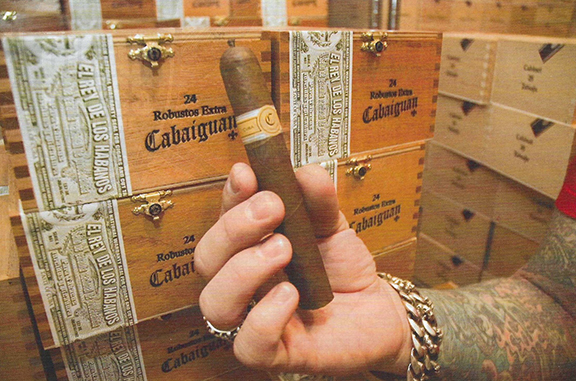 CP — Can you tell us a little bit about how you came up with names?
CP — Can you tell us a little bit about how you came up with names?
Pete — I really wanted cool names, but I also want them to reflect what the cigar is. Cabaiguan sounds kind of fresh. It happened to be a Connecticut Ecuador wrapper, which is very light and fresh When I came up with Cabaiguan I was sitting with Jaime in the Miami factory looking at a list of all the cities in Cuba. Cabaiguan was one that I really liked and no one owned the rights to. I happened to be reading an article the same week and Cabiaguan was listed as one of the most knowledgeable tobacco cities in Cuba. Tatuaje is obviously tattoo. The first six sizes I did with the brown label were called the Seleccion de Cazador, which means the selection of the hunter. Hunter was my first dog that passed away. I literally had this dog while I was growing up on the Sunset Strip. I always took him out and he hung out on the Strip with me That’s why I have Cazador tattooed on my arm. So people always say “a hunter’s selection,” but it’s Hunter’s selection. Hunter died early March 2003, and I had met Pepin late March. I knew something was meant to happen. I don’t have kids so when my dog passed away it was a life changing experience. I thought that I needed to do something with my life. Then I met this guy, wham. When Havana died I wanted to pay tribute to her. Pepin had just opened his Nicaraguan factory about twenty days after Havana died. I visited Nicaragua, got a blend set, and went over the sizes. If you take the first letter of all the Havana VI cigars, it spells Havana. Each size is representative to the size of the cigar. Victoria seems elegant, that’s why it’s a thinner cigar. Angeles is angel, so it’s a little baby cigar. Nobles is a robusto and very noble. Almirantes is admiral, so a Churchill. Artista is the torpedo, which is one of the cigars that are hard to make. It’s more of an artist’s cigar. Hermosos is just one of those cigars that is the perfect size. So it fits. It’s the same way with the original brown label. The sizes spell out Hunter. That was a trip, when I had to come up with those first six names. I ended up going through the Cuban catalog to see what cool names could spell out his name. Everything is going to have a meaning to me otherwise it’s not worth it. I want to make sure the cigars are absolutely perfect and representative to what they are. I’m not going to try to put out a piece of crap with a band on it.
CP — How do you go about creating all of your ideas and logos?
Pete — The creative process is a lot of fun. Sometimes I get ahead of myself because I love creating things. I have to slow down. This year I’m coming out with a new Cabaiguan and two limited edition red labels. I basically have plans for the brand through 2012.
CP -— Tell me about your new regional red labels.
Pete — Cuba does these regional cigars. So | made a joke to my sales reps about having their own special cigars to sell. I told them like Cuba, a regional cigar. They’re called Exclusivo, Zona del Este, and Exclusivo Lado Occidental. It’s east and west of the Mississippi. It will create a lot of hype, but they’re really good cigars. So hopefully people won’t discount the product by the amount of hype it will create. I think that the product will stand on its own. It’s going to be fun to see the east coast cigar people try to get the west coast cigars. We’ll end up having a lot of trans-shipping going on, which I don’t really like, but a lot of the retailers will end up trading just so they can get both on their shelves. This is me versus me. East Coast Pete vs. West Coast Pete, which Pete will win? Now that I’m up to a certain point in my business I’m able to have more fun, but I’ve always had fun.
CP — I love the red label, but everyone still wants to get the brown.
Pete — The brown label sells itself. I have certain retailers who have it and I keep it pre-allocated only because | don’t get enough of it. I’m trying to concentrate on the red. I’m trying to show people that the Nicaraguan products are just as good as the Miami product. It’s just a different cigar. It’s not that it’s not as good, it’s just different. Now that I have the red going, I want to put more focus on that. That’s why I came up with these regional cigars. It will really show people that we can make the same quality cigar as the brown, only with a different flavor profile. People will enjoy the reds as much as the browns. I’ll never get as much brown label as I need in order to really supply the whole country. My whole thing is not to sell to three thousand cigar stores.
CP — You make some great shirts and merchandise.
Pete — My uncle was in the fashion business and | thought it was really cool. I was always getting funky clothes from him. I thought it would be a fun business to go into because I’ve always been pretty creative. That’s why I became a musician. I was always into art. Ever since I was five | was going to art classes. That’s another reason I have crazy packaging on my ashtrays. I didn’t want to have a box that didn’t stand out. The ashtrays used to say Tautaje cigar ashtrays on the boxes. I told the makers to change it to Tatuaje, then underneath that put cigar ashtray. I don’t want to brand Tatuaje as just a cigar company, even though that’s my life force. I also want to have fun in different fields. This business is giving me the opportunity to have fun in those different fields. I’d bet that 98% of the people who wear Cool Water have no idea that Davidoff makes a cigar.
CP — You’re also doing something pretty cool at the shop here on Sunset.
Pete — I’ll fly out one of the rollers from the factory once a month just to roll for about a week to do a special cigar, it’s going to be the LA Tatuaje thing.
CP — You are definitely a boutique company that focuses more on quality than quantity.
Pete — I like the whole boutique thing. Someone asked me how many cigars I’ll make. I actually thought I was going to do close to 750,000 this year, but it’s close to about 900,000, maybe more. Then they asked if I thought I was still boutique. I said with all the different brands I have within the company, it’s still boutique. When you’re only making 30,000 or 40,000 of one size, it’s still small. 50,000 cigars of one size is only 2,000 boxes to supply the whole country. I have a lot of separation between the brands. I don’t think I’ll ever get to the point where I make 450,000 cigars of one size, one mark, that’s crazy. I’ve said since day one that I want to wake up in the morning and not feel like I have to put a gun to my head. | want to be part of everything that’s going on. You have to have some level of control otherwise it’s not worth it. I gotta do something for the rest of my life, if I don’t like it I’ll find some other work. I love this.
CP — While Pepin is an incredible cigar manufacturer, I don’t think that a lot of people understand that Tatuaje is a reflection of you. It’s not as though he gives you a cigar and says, this is Tatuaje.
Pete — That’s why he has his own brands. He has his own palate, and Jaime has his own palate, and that is why they make their own brands to sell. When I’m working with them, I’ll tell them whether or not I like a blend. We’ll work on it together to make something that I really enjoy. They have just as much to do with it as I do, but it’s to my flavor profile. For my brand, Pepin is like the orchestra and I’m the conductor. They have their brands, but when it comes to my brand I’m at the front waving my hands around telling them when to play the instruments that they know how to play. They know what they’re doing, but I know what I like. If I don’t like it I’ll tell them. It has to reflect me otherwise I can’t sell it.
Interview by: Thor Nielsen Photos by Jason Foraker






